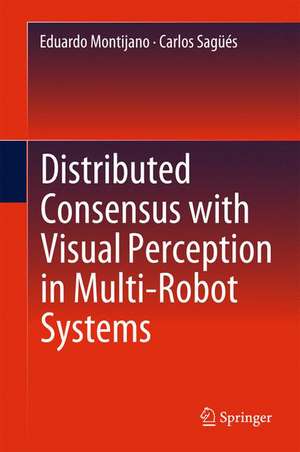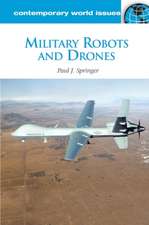Distributed Consensus with Visual Perception in Multi-Robot Systems
Autor Eduardo Montijano, Carlos Sagüésen Limba Engleză Hardback – 23 mar 2015
Distributed Consensus with Visual Perception in Multi-Robot Systems covers a variety of related topics such as:
• distributed consensus algorithms;
• data association and robustness problems;
• convergence speed; and
• cooperative mapping.
The book first puts forward algorithmic solutions to these problems and then supports them with empirical validations working with real images. It provides the reader with a deeper understanding of the problems associated to the perception of the world by a team of cooperating robots with onboard cameras.
Academic researchers and graduate students working with multi-robot systems, or investigating problems of distributed control or computer vision and cooperative perception will find this book of material assistance with their studies.
| Toate formatele și edițiile | Preț | Express |
|---|---|---|
| Paperback (1) | 550.32 lei 38-44 zile | |
| Springer International Publishing – 6 oct 2016 | 550.32 lei 38-44 zile | |
| Hardback (1) | 640.37 lei 43-57 zile | |
| Springer International Publishing – 23 mar 2015 | 640.37 lei 43-57 zile |
Preț: 640.37 lei
Preț vechi: 753.39 lei
-15% Nou
Puncte Express: 961
Preț estimativ în valută:
122.54€ • 128.26$ • 101.99£
122.54€ • 128.26$ • 101.99£
Carte tipărită la comandă
Livrare economică 31 martie-14 aprilie
Preluare comenzi: 021 569.72.76
Specificații
ISBN-13: 9783319156989
ISBN-10: 3319156985
Pagini: 150
Ilustrații: XII, 159 p. 46 illus. in color.
Dimensiuni: 155 x 235 x 15 mm
Greutate: 0.42 kg
Ediția:2015
Editura: Springer International Publishing
Colecția Springer
Locul publicării:Cham, Switzerland
ISBN-10: 3319156985
Pagini: 150
Ilustrații: XII, 159 p. 46 illus. in color.
Dimensiuni: 155 x 235 x 15 mm
Greutate: 0.42 kg
Ediția:2015
Editura: Springer International Publishing
Colecția Springer
Locul publicării:Cham, Switzerland
Public țintă
ResearchCuprins
Introduction.- Robotic Networks and the Consensus Problem.- The Data Association Problem.- D-RANSAC: Distributed Robot Consensus.- Fast Consensus with Chebyshev Polynomials.- Cooperative Topological Map Building Using Distributed Consensus.- Conclusions.
Textul de pe ultima copertă
This monograph introduces novel responses to the different problems that arise when multiple robots need to execute a task in cooperation, each robot in the team having a monocular camera as its primary input sensor. Its central proposition is that a consistent perception of the world is crucial for the good development of any multi-robot application. The text focuses on the high-level problem of cooperative perception by a multi-robot system: the idea that, depending on what each robot sees and its current situation, it will need to communicate these things to its fellows whenever possible to share what it has found and keep updated by them in its turn. However, in any realistic scenario, distributed solutions to this problem are not trivial and need to be addressed from as many angles as possible.
Distributed Consensus with Visual Perception in Multi-Robot Systems covers a variety of related topics such as:
· distributed consensus algorithms;
· data association and robustness problems;
· convergence speed; and
· cooperative mapping.
The book first puts forward algorithmic solutions to these problems and then supports them with empirical validations working with real images. It provides the reader with a deeper understanding of the problems associated to the perception of the world by a team of cooperating robots with onboard cameras.
Academic researchers and graduate students working with multi-robot systems, or investigating problems of distributed control or computer vision and cooperative perception will find this book of material assistance with their studies.
Distributed Consensus with Visual Perception in Multi-Robot Systems covers a variety of related topics such as:
· distributed consensus algorithms;
· data association and robustness problems;
· convergence speed; and
· cooperative mapping.
The book first puts forward algorithmic solutions to these problems and then supports them with empirical validations working with real images. It provides the reader with a deeper understanding of the problems associated to the perception of the world by a team of cooperating robots with onboard cameras.
Academic researchers and graduate students working with multi-robot systems, or investigating problems of distributed control or computer vision and cooperative perception will find this book of material assistance with their studies.
Caracteristici
Presents a novel application of visual sensing in multi-robot systems Provides a realistic perspective on issues of robustness, speed and bulk-data handling Verifies performance of algorithms by experimentation with real images Includes supplementary material: sn.pub/extras













